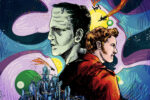From J.R.R. Tolkien’s Quenya and Sindarin to James Doohan and Marc Okrand’s Klingon, created languages have given authors, screenwriters and game creators the ability to bring worlds to life. The art and action of creating a language is called conlanging. Conlang is a shortened version of “constructed language,” and a conlanger is a person who does the language construction. Generally, a conlang falls into three categories of languages: engineered, auxiliary and artistic.
- Engineered languages, or engelangs, are developed for a specific purpose and are often used to experiment in logic, philosophy or linguistics.
- Auxiliary languages, or auxlangs, provide a way for people who do not share a common first tongue to communicate. Auxlangs are usually derived from popularly spoken tongues such as French, Spanish and English.
- Artistic languages, or artlangs, are the most widely known of the three and are comparable to other art forms, as an artlang is devised for pleasure and aesthetics.
Before the 19th century, linguists and philosophers dabbled in conlanging purely for scientific purposes and grammatical experimentation. But in the 19th century, as the world became increasingly interconnected and people worldwide interacted with each other, the idea of a universal auxlang surfaced, and numerous languages were proposed and created. Unlike in the past, the conlangs were complete and made to become widely used and accepted.
The languages Volapük and Esperanto arose from the push for a universal auxlang. Of the two, only Esperanto is still used, and it has since become the leading auxlang in terms of speakers and followers; it is even taught on Duolingo.
In the 20th century, conlanging started to become more than just a thought experiment. People like Tolkien began artlangs and inspired others to create their own languages. The popularity of conlanging increased dramatically, but it wasn’t until the advent of the internet that conlanging grew from small, close-knit communities of linguists and hobbyists into a field of viable career paths and a presence in pop culture.
Conlanging in Pop Culture and Its Ability to Enhance a Story
The rise of conlangs in pop culture can be attributed to works such as “The Lord of the Rings” and “Game of Thrones.” Tolkien’s numerous languages in “The Lord of the Rings” movies and Valyrian and Dothraki in “Game of Thrones” immerse viewers in a way that couldn’t be achieved without conlangs. Other films like “Avatar,” which garnered over a billion dollars, created the Na’vi language and further proved conlangs’ viability and usefulness in storytelling.
Viable career paths employing conlangers have arisen from the success of television shows and movies with conlangs. Previously, conlanging, in general, was seen as a “nerdy” hobby with little to no real-life payoff. Hollywood and other media outlets thought fictional tongues would drive audiences away; Klingon in “Star Trek” was considered ridiculous when it first appeared on screen. But following the success of “Game of Thrones,” numerous groups asked David J. Peterson, the creator of Dothraki and Valyrian, to produce languages for them. Peterson has since made conlanging into a career and is a prime example of how far conlanging has come.
Before the 2000s and the growth of fictional tongues, media could get away with primitive, incomplete languages. However, since “Game of Thrones,” consumers and producers now expect, and sometimes require, that those who seek to create a fictional world via television or print have a conlang.
The need for a fictional language in a created world is understandable. Language allows people to understand each other, and its use tells a story of the culture and its values. The level of depth and development lost without a language to supplement a fictional culture can be detrimental to a story.
How To Conlang
You do not need to have a Ph.D. in linguistics to get involved in conlanging, but understanding some definitions is vital. There is no right way to create your own language, but plenty of resources provide guidelines to follow. Some websites and communities offer guidance and support in the language creation process if needed, like Reddit and the Language Creation Society.
It is generally agreed that you should first define what type of language you want to create before you start. Knowing what you want can help you skip specific steps you would otherwise need to do. For example, suppose you are making a language used specifically for naming characters and places. In that case, you don’t need to develop a whole grammatical structure or an expansive vocabulary, just enough to create names.
After you’ve decided what type of language you want, there are three things that you will need to create, in order:
- Phonology: how you want your language to sound and how you want each sound to be represented. This can be achieved through the International Phonetic Alphabet (IPA), a collection of possible sounds humans can make represented as symbols. The IPA has two charts, one for consonants and one for vowels, which you can use to find and fill out your sounds.
- Grammar: the way sentences and words are formed. You will need to define your language’s syllables and composition if it uses such conventions.
- Lexicon: words and phrases. This is the dictionary of your language or, in other words, the fun part where all your hard work comes together and you finally get results.
How you start is essential. You cannot generate a lexicon without first creating grammar, and you cannot develop grammar without phonology.
The three steps provided here are streamlined and missing the nuances of the art of conlanging; there are many different ways to complicate your language and more difficult points to understand. Add changes in verbs when in action, masculine and feminine forms and different tenses, and you can see how complex a language can get.
The evolution of conlanging from philosophical and scientific experiments to a form of art and pop culture has been a long one. Still, the new opportunities it has opened for world-building and careers are immense. This complex and obscure art could be the perfect hobby for you to try out; conlanging takes time, effort and patience, but it can be rewarding and fun if you stick with it.
















